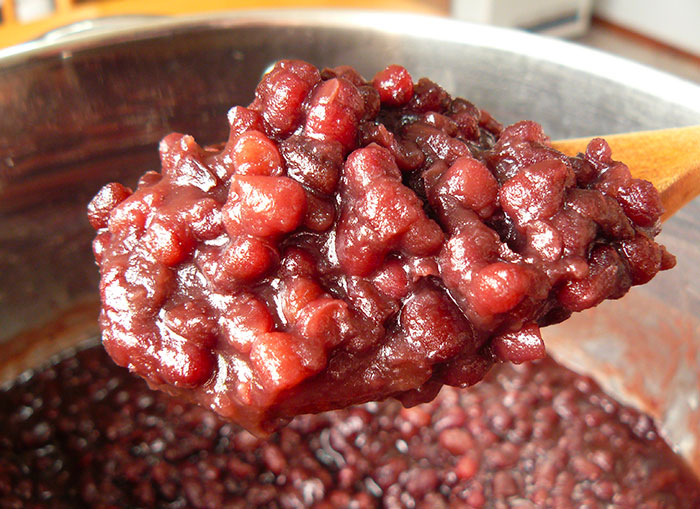
Tsubuan
| Ingredient | About 2.5 lbs. | About 1kg |
|---|---|---|
| dried azuki beans | ⅔ pound | 300g |
| sugar | 1½ cups | 300-350g |
| salt | ¼ tsp. | ¼ tsp. |
If you’ve never had anko (azuki bean paste, sometimes spelled adzuki) before, it’s tastier than it sounds — a little like sweeter, drier baked beans perhaps. It can be eaten straight, but baked into anpan (pan means “bread” in Japanese) it’s one of the most popular snacks for Japanese children, and loved by adults as well. It also makes for an elegant, and somewhat exotic, topping for matcha cake.
This recipe is for tsubuan, chunkier anko that still has whole beans in it. Koshian has a smoother, more paste-like texture.
Directions
- Wash the beans.
Rinse the dried beans in cold water. Older beans take longer to absorb water, so you might also need to let them soak in a pan of cool water for a while. Don’t soak them for longer than 10 hours, though — they will taste off. - Cook the beans.
Put the beans in a large pot with just enough water to cover the beans (about two and a half cups). Bring the beans to a boil over high heat, then reduce the heat to medium and simmer, uncovered, for about 10 minutes. The surface of the beans will wrinkle and the water will turn dark brown. Skim off any scum that forms on top of the water; this will improve the flavor. - Add cold water.
Pour about two cups of cold water into the pot; this will help the beans cook through more evenly. - Boil until beans become smooth.
Let the beans return to a boil, then reduce the heat to low. Continue to simmer uncovered until the surface of the beans becomes smooth and the liquid turns a darker shade of brown, then remove from heat. - Drain and rinse beans.
Pour the beans into a strainer and let the liquid drain off, then rinse briefly with cold running water. - Simmer covered with foil.
Return the beans to the pot and add enough cold water to just cover (about two and a half cups). Bring the pot to a boil over high heat, then reduce to low. To keep the beans from moving around, tear a piece of aluminum foil larger than the pot and press it down so it rests flat on the top of the beans. Simmer covered with this foil for one hour. - Continue cooking beans.
You can check to make sure the beans are fully cooked by squeezing one between your fingers; it should smash easily. Continue cooking, covered with foil, until most of the liquid is gone, but be careful not to burn the beans. - Add sugar.
Sprinkle one fifth of the sugar over the top of the beans and replace the foil. Simmer without stirring until the sugar disappears, about 5 minutes. Sprinkle another fifth of the sugar and again simmer, covered with foil, until the sugar disappears. The sugar will draw out some of the moisture in the beans, so they will get more watery. - Add the remaining sugar and salt, and cook.
Sprinkle on half of the remaining sugar, still without stirring, and cook, covered with the foil, until it disappears. Add the remaining sugar and salt, cover again, and simmer until they disappear. - Remove foil and cook.
Once the beans start to look moist and glossy, remove the foil. Begin stirring with a wooden spoon and continue simmering to boil off some of the remaining liquid. Once you can draw the spoon across the beans and the bottom of the pot remains visible, they are done. For softer anko (for example, to use as a topping), cut the final boiling time short.
Notes
- Depending on what you’re using the anko for, you may want to adjust the consistency by boiling off more or less of the water at the very end. For example, if you’re using it as a topping for matcha cake, you’ll probably want it a little on the watery side. If you’re using it as filling for anpan, you’ll want it relatively firm.
- The reason you want to add sugar so gradually is so they will properly absorb water and soften; if you put it all in at once, they’ll end up somewhat hard.
- Anko holds up well in the fridge, and can also be frozen for a few weeks if you have extra.
